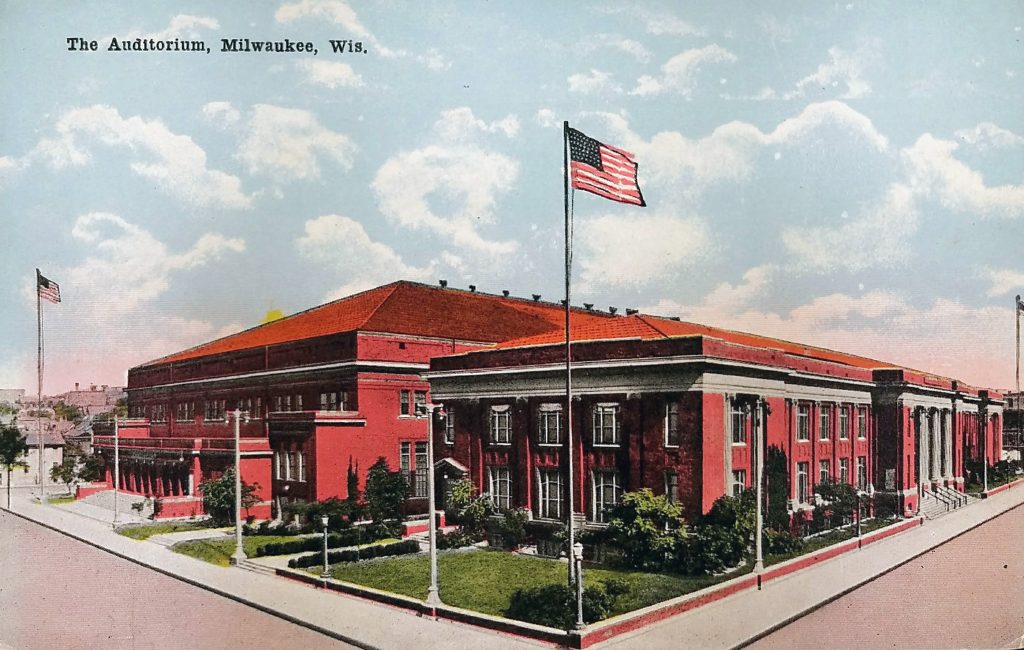
This undated postcard is of the Milwaukee Auditorium (which is now known as the Miller High Life Theatre).
This site has been a public gathering spot for Milwaukeeans since the earliest years of the city. In 1835, Byron Kilbourn bequeathed the land to the city with the stipulation it be used as public grounds, house a public marketplace, and a specific part would never be built upon. In 1867, Market Hall, a small arcade was built on the site.
Market Hall was torn down in 1880, and the land was given in a 50-year lease to the Milwaukee Industrial Exposition Association in order to build an exposition hall for the city. The Kilbourn family brought an injunction against the city for using the land for non-public use, but the city obtained their permission for the structure. In 1881, a grand Exposition Hall was opened at this location. The hall had the first electric lights in a public building in Milwaukee and featured a large pipe organ, an art gallery, and was the first home of the Milwaukee Public Museum. The building burned down while hosting a card tournament in June of 1905.
Plans began immediately to replace the Exposition Hall with an auditorium. Some of Kilbourn’s heirs continued to protest that the use of the property would not be purely public; eventually, the Supreme Court ruled that the Auditorium fulfilled the stipulations of Byron Kilbourn’s donation. Since then, his heirs have not disputed the use of the land. The Milwaukee Auditorium opened on September 21, 1909.
On October 14, 1912, former president and then-current presidential candidate Theodore Roosevelt delivered a speech at the Milwaukee Auditorium shortly after a failed assassination attempt that left him with a bullet in his chest. He was shot a block away from the Auditorium at the Gilpatrick Hotel but declined to go to the hospital before giving his speech. The bullet lodged in Roosevelt’s chest only after hitting both his steel eyeglass case and a 50-page copy of his speech.
Roosevelt began his speech by saying, “Friends, I shall ask you to be as quiet as possible. I don’t know whether you fully understand that I have just been shot.” He delivered his scheduled speech with blood seeping into his shirt and spoke for 90 minutes. An X-ray showed that the bullet had lodged in Roosevelt’s chest muscle but did not penetrate the pleura. Doctors concluded that it would be less dangerous to leave it in place than to attempt to remove it, and Roosevelt carried the bullet with him for the rest of his life. He died seven years later.
Roosevelt’s would-be assassin was John Schrank, an unemployed New York City saloonkeeper who had stalked his prey around the country for weeks. He had dreamt that President McKinley sat up in his coffin, pointed at Theodore Roosevelt, called him a murderer, and demanded his death be avenged. (McKinley was assassinated in 1901 by an anarchist.) Schrank pled guilty, was determined to be insane, and spent 29 years in the Central State Hospital for the Criminally Insane in Waupun, Wisconsin before dying in 1943.
The Auditorium was the site of other controversial and newsworthy happenings. During the influenza epidemic of 1917 and 1918, the Auditorium instigated “influenza seating;” rows were spaced widely, and monitors sat at the ends to catch signs of sickness. When the sickness was at its height, the building became a hospital to care for the afflicted.
In the 1920s, the Ku Klux Klan wanted to have a rally in the building “to teach law and order.” Mayor Daniel W. Hoan wrote back, “you come here and touch a hair on the head of one Catholic, one Jew, one chiropractor, or one anything else, and I’ll make this the hottest place this side of hell for the Ku Klux Klan.” In 1938, a German group was not allowed to meet in the structure because of tension caused by World War II (despite Milwaukee’s deep German heritage).
The theater has hosted many of the nation’s most famous artists. Opera stars Geraldine Farrar, Olga Samaroff and Enrico Caruso performed on stage. So did John Philip Sousa and Louis Armstrong. In 1948, the Polka King contest crowned legendary Frankie Yankovic and Four Cleveland Kids as the best polka band. In the 1960s and 1970s, the list of artists who performed here included Herman’s Hermits, Lou Reed, Santana, Frank Zappa, The Kinks, Rush, The Grateful Dead, Bob Dylan, Alice Cooper, Kiss, and Phil Collins.
To the right, you see 5th Street. The Auditorium Annex housed the original front façade along Fifth Street. The street was closed when the Arena was built next door in 1950, and today the front entrance is on Kilbourn.
Sources:
https://urbanmilwaukee.com/2015/09/01/yesterdays-milwaukee-public-museum-exhibits-1880s/
http://www.gendisasters.com/wisconsin/9641/milwaukee-wi-exposition-fire-june-1905
https://www.wisconsinhistory.org/Records/Property/HI73319
https://www.concertarchives.org/venues/milwaukee-auditorium
https://en.wikipedia.org/wiki/Miller_High_Life_Theatre
https://www.history.com/news/shot-in-the-chest-100-years-ago-teddy-roosevelt-kept-on-talking
Identifiers:
PLUS Code: 23RJ+RP Milwaukee, Wisconsin
Approximate Google Steet View today: https://goo.gl/maps/KbTkDKH64NzTMD9J8
It’s always great to read Milwaukee’s history here on this site.
I’m glad to hear you like it. If you have any special requests, let me know.